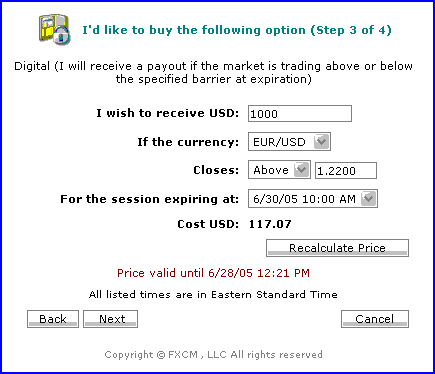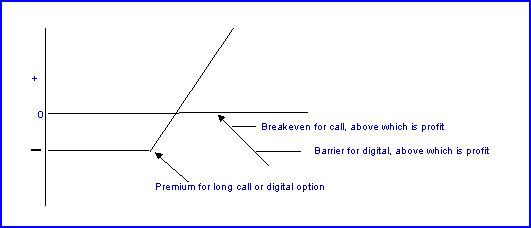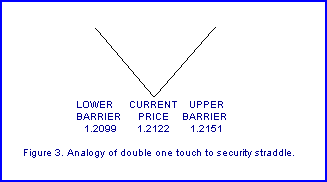
HOT TOPICS LIST
- Strategies
- Stocks
- Buy
- Investing
- Brokers
- Psychology
- Interviews
- Accumulate
- Sell
- Hold
- Spotlight
- Websites
- Candlestick Corner
- Gold & Metals
- Options Trading
LIST OF TOPICS
TRADER'S NOTEBOOK
Forex Options: Are They Really Exotic?
07/20/05 02:33:16 PM PSTby Rudy Teseo
Any similarity to actual security options is not coincidental...
| "Exotic" — is it just a name for options? Or could it also be an acronym? Maybe something like, "Extremely Xtraordinary Options That Insure Compensation (or Commissions)." Whatever it means to you, "Exotic" is the name given to the five unique strategies available in the currency market. They may appear very complex when initially compared to the 20 or so standard strategies published by the CBOE, but a little study reveals that they are really quite simple. And, since there are only five, they can be memorized quite easily. As you will soon learn, they are aptly named -- the name describes the strategy. When we look at profit/loss curves, they won't seem strange at all.
FIXED RATE OPTIONS TRADING ·Digital
Although there are slight differences between these five strategies, the premium you pay for each is determined by the selections you make for payout, strike price (barrier level), and expiration date.
Digital Your time frame determines the selections you make. For a short-term expiration, you might look at a couple weeks of history to observe the highs and lows of the period before selecting a barrier level. For a longer period, you would look at a month or two. Digital options are relatively cheap; typically, you could expect a payout of $1,000 with a premium of $100 $200. That's a pretty good risk/reward! Of course, for this R/R, your time to expiration would be a matter of days, and the barrier would have to be considerably away from the current price. After all, the trader selling you this option is not looking to make you a gift. Figure 1 is a typical order entry screen. Prior to this screen would be the screen in which you select the one of the five strategies you want to buy or sell. Having selected digital options, this screen shows that the premium for a $1,000 payout is $117.07.
Figure 1: Order entry screen. Figure 2 shows a profit/loss curve showing the similarities between a security long call and a digital option. Both options start as a debit, which is the premium paid. The breakeven level for the call, above which the option is profitable, is like the barrier level for the digital option, above which the option is profitable. There is one big difference, however: with the security option, you must decide to sell or exercise before expiration. The digital option saves you a lot of monitoring, since your payout is immediately credited to your account as soon as the barrier is reached; this all applies equally to a digital put.
Figure 2: Digital option and security long call.
No-Touch If the trend is up, you would select a barrier below the current price. You are in effect buying a call. Even though selecting a barrier below the current price seems bearish, you are betting that the price will continue to increase and never touch your barrier. Ergo: No touch. Conversely, if the current trend is down, you would select a barrier above the current price level. You are in effect buying a put. If the barrier is touched before expiration, the option expires worthless.
One-Touch
Double-One-Touch Now, if during the expiration period the price breaks out of either barrier, (double barriers, one touch) your payout would be $5,000. If there is no breakout before expiration, you lose your premium, but you still have the profit of your range trade. Your profit is $5,000, your risk $2,200 — a reward/risk better than 2:1. That's a good hedge. Figure 3 is a profit/loss curve showing the similarity of this strategy to a security straddle. The major difference is that with the double-one touch-you're assured of $5,000 (minus the premium) in either direction, whereas with the straddle, the profit depends upon the direction the price takes and the difference between the call and put prices. Again, you have to make decisions with the straddle, whereas the double-one-touch option pays immediately.
Figure 3: Double-one-touch and a security straddle.
Double-No-Touch If either barrier is breached at any time before expiration, your premium expires worthless, but you have the profit from your breakout. If neither barrier is touched (double barriers, no touch) you are immediately credited with the payout.
For all of these "exotic" options, as with every new strategy or technique, it is advisable to open a demo account and practice often until you're entirely comfortable. If you have never traded multi-leg security options, then perhaps some additional study would be prudent.
Rudy Teseo is a private investor and currency trader, and has taught classes in option trading and technical analysis. He can be reached at RFTESS@Juno.com. SUGGESTED READING Current and past articles from Working Money, The Investors' Magazine, can be found at Working-Money.com. |
Rudy Teseo is a private investor who trades stocks, options, and currencies. He has taught classes in technical analysis and option trading. He may be reached at rftess@optonline.net.
| E-mail address: | rftess@optonline.net |
PRINT THIS ARTICLE

|

Request Information From Our Sponsors
- StockCharts.com, Inc.
- Candle Patterns
- Candlestick Charting Explained
- Intermarket Technical Analysis
- John Murphy on Chart Analysis
- John Murphy's Chart Pattern Recognition
- John Murphy's Market Message
- MurphyExplainsMarketAnalysis-Intermarket Analysis
- MurphyExplainsMarketAnalysis-Visual Analysis
- StockCharts.com
- Technical Analysis of the Financial Markets
- The Visual Investor
- VectorVest, Inc.
- Executive Premier Workshop
- One-Day Options Course
- OptionsPro
- Retirement Income Workshop
- Sure-Fire Trading Systems (VectorVest, Inc.)
- Trading as a Business Workshop
- VectorVest 7 EOD
- VectorVest 7 RealTime/IntraDay
- VectorVest AutoTester
- VectorVest Educational Services
- VectorVest OnLine
- VectorVest Options Analyzer
- VectorVest ProGraphics v6.0
- VectorVest ProTrader 7
- VectorVest RealTime Derby Tool
- VectorVest Simulator
- VectorVest Variator
- VectorVest Watchdog



